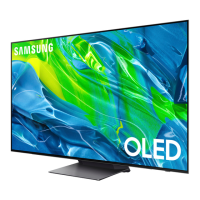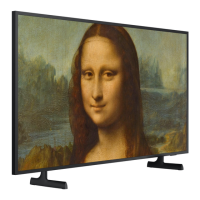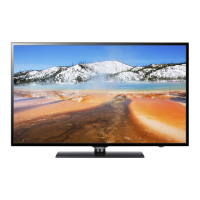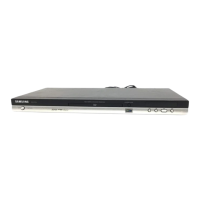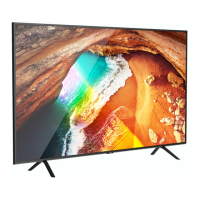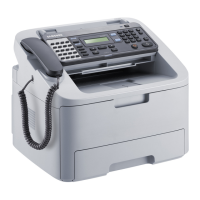Do you have a question about the Samsung 650 Series and is the answer not in the manual?
Explains digital television and its services like HDTV, SDTV, multicasting.
Details different digital TV formats and their quality compared to analog.
Guidelines for optimal viewing distance and comfort for the TV screen.
Highlights the key features and technologies integrated into the TV.
Manuals and guides included with the product.
Components for operating the TV remotely.
Describes the function of physical buttons on the TV's control panel.
Details the various input/output ports located on the back of the TV.
Describes the input/output ports available on the side of the TV.
Explains the function of each button on the TV remote control.
Step-by-step guide for inserting batteries into the remote control.
Instructions for connecting traditional TV antennas to the TV.
How to connect cable TV directly if the TV is cable-ready.
Connecting a cable box that descrambles all channels.
Connecting a cable box requiring additional setup for specific channels.
Guide for connecting external devices using HDMI for optimal picture quality.
Instructions for connecting devices using a DVI interface.
How to connect devices using component video cables for enhanced quality.
Guide for connecting a camcorder using the TV's AV inputs.
Standard video and audio connections for a VCR.
Using S-Video for improved picture quality from a VCR.
How to connect a digital audio system using an optical cable.
Guide for connecting an audio amplifier or home theater system.
Connecting a computer using a D-Sub (VGA) cable.
Connecting a computer using HDMI or DVI with audio.
Basic procedure for powering the television on and off.
Initial setup guide for language, channels, and basic settings.
How to change channels using the CH +/- buttons.
Direct channel selection using the numeric keypad.
Selecting digital channels or HD/SD signals.
Switching to the previously viewed channel.
Adjusting the TV's sound level.
Temporarily silencing the TV's audio output.
Displaying current channel and setting information.
How to access and navigate the TV's on-screen menu system.
Using the TOOLS button for fast access to frequently used functions.
Specifying the signal source (Air or Cable) before channel memorization.
Simplified method for memorizing channels.
Step-by-step guide for automatic channel scanning and storage.
How to choose and switch between different external input sources.
Renaming input sources for easier identification.
Selecting picture modes like Dynamic, Standard, or Movie.
Adjusting specific picture parameters like brightness, contrast, and color.
Accessing advanced picture adjustments for precise control.
Adjusting the black level for enhanced screen depth.
Optimizing screen contrast for better image detail.
Modifying the primary color intensity (Red, Green, Blue).
Fine-tuning color temperature for more natural picture colors.
Adjusting the pink flesh tone in the picture for better realism.
Sharpening image details by enhancing object boundaries.
Enabling xvYCC for increased detail and color space in HDMI/Component mode.
Accessing and configuring various picture settings.
Selecting preferred color tones like Cool, Normal, or Warm.
Choosing from six screen size options for optimal viewing.
Adjusting the horizontal and vertical position of the PC screen.
Activating noise reduction to improve picture clarity.
Enhancing visual quality with 3D noise reduction and contrast.
Adjusting the black level of the picture when in HDMI mode.
Setting the TV to automatically process film signals for optimal picture.
Using Blue Only Mode for AV device measurement experts.
Selecting color gamuts like Normal or sRGB for preferred color matrix.
Steps for connecting PC and emitter for 3D effect.
Choosing between Mode1 and Mode2 for 3D effect synchronization.
Resetting all picture settings to their original factory defaults.
Selecting sound modes like Standard, Music, Movie, or Speech.
Adjusting sound equalizer settings for personalized audio.
Resetting the equalizer settings to their factory defaults.
Activating SRS TruSurround XT for virtual surround sound through TV speakers.
Choosing preferred audio language for digital TV broadcasts.
Choosing between Mono, Stereo, or SAP for analog TV audio.
Reducing volume differences between broadcasters.
Turning the TV's internal speakers on or off.
Resetting all sound settings to their original factory defaults.
Adding, deleting, and organizing TV channels.
Displaying a list of all available channels after auto-program.
Procedures for removing or adding channels from the channel list.
Setting preferred channels for quick access.
Simple method to add or delete channels from favorites.
Scheduling programs to record or watch automatically.
Using the program guide to reserve broadcasts.
Viewing, modifying, or canceling scheduled program reservations.
Changing the details of an existing program reservation.
Removing a scheduled program reservation.
Customizing analog channel labels with call letters.
Storing available channels via the auto program feature.
Removing scrambled channels from the digital channel list.
Manually adjusting analog channels for optimal reception.
Verifying and improving digital channel signal strength.
Connecting and configuring the TV as a PC monitor.
Information on optimized display modes for PC input.
Automatically adjusting PC video signals for optimal display.
Removing picture noise and fine-tuning the display.
Adjusting the horizontal and vertical position of the PC screen.
Restoring all PC display settings to factory defaults.
Setting the TV's internal clock for timer features and time display.
Step-by-step guide for manual clock setting.
Setting the clock automatically via digital signal reception.
Setting the TV to turn on or off at specific times.
Setting a timer for the TV to automatically turn off.
Changing the language used for the TV's on-screen menus.
Establishing a PIN for V-Chip access and parental controls.
Enabling or disabling the V-Chip feature.
Configuring restrictions based on TV program age-based categories.
Fine-tuning specific content restriction sub-ratings.
Configuring restrictions based on movie ratings (MPAA).
Configuring content restrictions using Canadian English rating systems.
Configuring content restrictions using Canadian French rating systems.
Using V-Chip for parental control on digital TV channels.
Procedure to bypass V-Chip restrictions if channels are blocked.
Configuring display options for digital closed captions.
Configuring display options for analog closed captions.
Adjusting the volume of the TV's startup and shutdown melody.
Selecting modes to optimize display and sound for specific content.
Steps for updating the TV's firmware using a USB drive.
Viewing photos (JPEG) and playing music (MP3) from USB devices.
Explains remote control functions within the WISELINK menu.
Accessing and navigating through the WISELINK menu items.
Shows photo files and folders saved on a USB device.
Information on how photos and their details are displayed.
Displays details about the selected photo, allowing changes to color, composition, and favorite status.
Changing the criteria for sorting photos.
Shows sorting groups for photos.
Displays the name of the currently selected USB device.
Shows the count of selected photos.
Explains the function of remote control buttons within the Photo List.
Options for sorting photos by month, time, color, composition, folder, or preference.
Sorting photos chronologically by month.
Sorting photos chronologically by date.
Sorting photos based on their folder structure.
Changing the color information for photos and grouping them.
Changing the composition information for photos and grouping them.
Assigning favorite status to photos, indicated by stars.
Deleting individual photo files from the USB device.
Selecting and deleting multiple photo files simultaneously.
Viewing information like name, size, resolution, and path of photo files.
Displaying a selected photo in full screen mode.
Automatically displaying photos in a sequence.
Using the TOOLS menu for options during slide shows or photo viewing.
Starting or stopping the automatic photo slideshow.
Rotating images in full screen mode.
Zooming into images for closer viewing.
Adjusting the speed at which photos transition in a slideshow.
Playing music files during photo slideshows.
Choosing music playback modes: Shuffle, Selected file, or Mood.
Refer to page 24 for picture mode settings.
Refer to page 34 for sound mode settings.
Displaying details about the connected USB device.
Procedure for safely removing USB storage devices.
Shows MP3 files saved on a USB device.
Information on how music files and their details are displayed.
Changing the criteria for sorting music files.
Shows sorting groups for music files.
Displays the name of the currently selected USB device.
Shows the count of selected music files.
Explains the function of remote control buttons within the Music List.
Organizing music files alphabetically by title.
Organizing music files alphabetically by artist.
Sorting music files by genre.
Sorting music files based on their folder structure.
Changing the mood information for music files and grouping them.
Assigning favorite status to music files.
Deleting individual music files from the USB device.
Selecting and deleting multiple music files.
Viewing information like name, size, date, and path of music files.
Playing an MP3 file from the USB device.
Playing multiple music files from a selected group.
Selecting multiple music files for playback.
Configuring music playback to repeat.
Adjusting the speed of photo slideshows.
Setting music playback to repeat.
Setting the delay before the screen saver activates.
Viewing information about the connected USB device.
Safely ejecting USB devices.
Explains Anynet+ feature for controlling Samsung devices with one remote.
Guides for connecting Anynet+ compatible devices to the TV and home theater.
Setting Anynet+ (HDMI-CEC) to On for full functionality.
Configuring devices to power off with the TV.
Scanning for connected Anynet+ devices and switching between them.
Switching to TV broadcast mode within Anynet+.
Displaying a list of connected Anynet+ devices.
Procedures for recording TV programs using a Samsung recorder.
Routing TV audio through a connected home theater system.
Troubleshooting guide for Anynet+ connectivity and functionality problems.
General troubleshooting guide for common TV problems and solutions.
Step-by-step instructions for replacing the TV lamp.
Tips for cleaning the TV's cabinet and screen.
Advice on using the TV in different countries with varying TV systems.
Detailed technical data including model name, screen size, and dimensions.
Operating and storage requirements for temperature and humidity.
Information on software licenses used in the product.
Information on LGPL licenses applicable to certain libraries.
Diagrams identifying all rear and side panel connection jacks.
Detailed breakdown of each button's function on the remote control.
Guide for connecting external devices using HDMI for optimal picture quality.
Instructions for connecting devices using a DVI interface.
How to connect devices using component video cables for enhanced quality.
Guide for connecting a camcorder using the TV's AV inputs.
Standard video and audio connections for a VCR.
Using S-Video for improved picture quality from a VCR.
How to connect a digital audio system using an optical cable.
Guide for connecting an audio amplifier or home theater system.
Connecting a computer using a D-Sub (VGA) cable.
Connecting a computer using HDMI or DVI with audio.
Basic procedure for powering the television on and off.
Using the INFO button to check channel and setting status.
Navigating the TV's on-screen menu system.
Memorizing available channels automatically.
Choosing picture modes like Dynamic, Standard, or Movie.
How to choose and switch between different external input sources.
Explains the meaning of the TV's front panel indicator lights.
Guidelines for screen viewing distance and comfort.
A guide to diagnosing and resolving typical issues with the TV.
Important safety warnings regarding product usage, ventilation, and handling.
Advice on managing screen reflections from external light sources.
Information about the cooling fan's operation after power off.
Explanation of minor pixel variations and their impact on performance.
Guidelines for cleaning the TV screen safely and effectively.
Recommendations for maintaining viewing distance during extended use.
Notice regarding the transition to digital television broadcasting in the USA.
An example analyzing communication protocol messages for DLP DTV control.
Settings for serial port communication with the DLP DTV.
Details on the structure of command packets for controlling the TV.
Structure of response packets indicating success or failure.
Describes the sequence of communication between PC and DLP DTV.
Outlines the warranty duration and conditions for the product.
Recommendations for viewing standard 4:3 format video.
Recommendations for viewing wide 16:9 format video.
Explains digital television and its services like HDTV, SDTV, multicasting.
Details different digital TV formats and their quality compared to analog.
Guidelines for optimal viewing distance and comfort for the TV screen.
Highlights the key features and technologies integrated into the TV.
Manuals and guides included with the product.
Components for operating the TV remotely.
Describes the function of physical buttons on the TV's control panel.
Details the various input/output ports located on the back of the TV.
Describes the input/output ports available on the side of the TV.
Explains the function of each button on the TV remote control.
Step-by-step guide for inserting batteries into the remote control.
Instructions for connecting traditional TV antennas to the TV.
How to connect cable TV directly if the TV is cable-ready.
Connecting a cable box that descrambles all channels.
Connecting a cable box requiring additional setup for specific channels.
Guide for connecting external devices using HDMI for optimal picture quality.
Instructions for connecting devices using a DVI interface.
How to connect devices using component video cables for enhanced quality.
Guide for connecting a camcorder using the TV's AV inputs.
Standard video and audio connections for a VCR.
Using S-Video for improved picture quality from a VCR.
How to connect a digital audio system using an optical cable.
Guide for connecting an audio amplifier or home theater system.
Connecting a computer using a D-Sub (VGA) cable.
Connecting a computer using HDMI or DVI with audio.
Basic procedure for powering the television on and off.
Initial setup guide for language, channels, and basic settings.
How to change channels using the CH +/- buttons.
Direct channel selection using the numeric keypad.
Selecting digital channels or HD/SD signals.
Switching to the previously viewed channel.
Adjusting the TV's sound level.
Temporarily silencing the TV's audio output.
Displaying current channel and setting information.
How to access and navigate the TV's on-screen menu system.
Using the TOOLS button for fast access to frequently used functions.
Specifying the signal source (Air or Cable) before channel memorization.
Simplified method for memorizing channels.
Step-by-step guide for automatic channel scanning and storage.
How to choose and switch between different external input sources.
Renaming input sources for easier identification.
Selecting picture modes like Dynamic, Standard, or Movie.
Adjusting specific picture parameters like brightness, contrast, and color.
Accessing advanced picture adjustments for precise control.
Adjusting the black level for enhanced screen depth.
Optimizing screen contrast for better image detail.
Modifying the primary color intensity (Red, Green, Blue).
Fine-tuning color temperature for more natural picture colors.
Adjusting the pink flesh tone in the picture for better realism.
Sharpening image details by enhancing object boundaries.
Enabling xvYCC for increased detail and color space in HDMI/Component mode.
Accessing and configuring various picture settings.
Selecting preferred color tones like Cool, Normal, or Warm.
Choosing from six screen size options for optimal viewing.
Adjusting the horizontal and vertical position of the PC screen.
Activating noise reduction to improve picture clarity.
Enhancing visual quality with 3D noise reduction and contrast.
Adjusting the black level of the picture when in HDMI mode.
Setting the TV to automatically process film signals for optimal picture.
Using Blue Only Mode for AV device measurement experts.
Selecting color gamuts like Normal or sRGB for preferred color matrix.
Steps for connecting PC and emitter for 3D effect.
Choosing between Mode1 and Mode2 for 3D effect synchronization.
Resetting all picture settings to their original factory defaults.
Selecting sound modes like Standard, Music, Movie, or Speech.
Adjusting sound equalizer settings for personalized audio.
Resetting the equalizer settings to their factory defaults.
Activating SRS TruSurround XT for virtual surround sound through TV speakers.
Choosing preferred audio language for digital TV broadcasts.
Choosing between Mono, Stereo, or SAP for analog TV audio.
Reducing volume differences between broadcasters.
Turning the TV's internal speakers on or off.
Resetting all sound settings to their original factory defaults.
Adding, deleting, and organizing TV channels.
Displaying a list of all available channels after auto-program.
Procedures for removing or adding channels from the channel list.
Setting preferred channels for quick access.
Simple method to add or delete channels from favorites.
Scheduling programs to record or watch automatically.
Using the program guide to reserve broadcasts.
Viewing, modifying, or canceling scheduled program reservations.
Changing the details of an existing program reservation.
Removing a scheduled program reservation.
Customizing analog channel labels with call letters.
Storing available channels via the auto program feature.
Removing scrambled channels from the digital channel list.
Manually adjusting analog channels for optimal reception.
Verifying and improving digital channel signal strength.
Connecting and configuring the TV as a PC monitor.
Information on optimized display modes for PC input.
Automatically adjusting PC video signals for optimal display.
Removing picture noise and fine-tuning the display.
Adjusting the horizontal and vertical position of the PC screen.
Restoring all PC display settings to factory defaults.
Setting the TV's internal clock for timer features and time display.
Step-by-step guide for manual clock setting.
Setting the clock automatically via digital signal reception.
Setting the TV to turn on or off at specific times.
Setting a timer for the TV to automatically turn off.
Changing the language used for the TV's on-screen menus.
Establishing a PIN for V-Chip access and parental controls.
Enabling or disabling the V-Chip feature.
Configuring restrictions based on TV program age-based categories.
Fine-tuning specific content restriction sub-ratings.
Configuring restrictions based on movie ratings (MPAA).
Configuring content restrictions using Canadian English rating systems.
Configuring content restrictions using Canadian French rating systems.
Using V-Chip for parental control on digital TV channels.
Procedure to bypass V-Chip restrictions if channels are blocked.
Configuring display options for digital closed captions.
Configuring display options for analog closed captions.
Adjusting the volume of the TV's startup and shutdown melody.
Selecting modes to optimize display and sound for specific content.
Steps for updating the TV's firmware using a USB drive.
Viewing photos (JPEG) and playing music (MP3) from USB devices.
Explains remote control functions within the WISELINK menu.
Accessing and navigating through the WISELINK menu items.
Shows photo files and folders saved on a USB device.
Information on how photos and their details are displayed.
Displays details about the selected photo, allowing changes to color, composition, and favorite status.
Changing the criteria for sorting photos.
Shows sorting groups for photos.
Displays the name of the currently selected USB device.
Shows the count of selected photos.
Explains the function of remote control buttons within the Photo List.
Options for sorting photos by month, time, color, composition, folder, or preference.
Sorting photos chronologically by month.
Sorting photos chronologically by date.
Sorting photos based on their folder structure.
Changing the color information for photos and grouping them.
Changing the composition information for photos and grouping them.
Assigning favorite status to photos, indicated by stars.
Deleting individual photo files from the USB device.
Selecting and deleting multiple photo files simultaneously.
Viewing information like name, size, resolution, and path of photo files.
Displaying a selected photo in full screen mode.
Automatically displaying photos in a sequence.
Using the TOOLS menu for options during slide shows or photo viewing.
Starting or stopping the automatic photo slideshow.
Rotating images in full screen mode.
Zooming into images for closer viewing.
Adjusting the speed at which photos transition in a slideshow.
Playing music files during photo slideshows.
Choosing music playback modes: Shuffle, Selected file, or Mood.
Refer to page 24 for picture mode settings.
Refer to page 34 for sound mode settings.
Displaying details about the connected USB device.
Procedure for safely removing USB storage devices.
Shows MP3 files saved on a USB device.
Information on how music files and their details are displayed.
Changing the criteria for sorting music files.
Shows sorting groups for music files.
Displays the name of the currently selected USB device.
Shows the count of selected music files.
Explains the function of remote control buttons within the Music List.
Organizing music files alphabetically by title.
Organizing music files alphabetically by artist.
Sorting music files by genre.
Sorting music files based on their folder structure.
Changing the mood information for music files and grouping them.
Assigning favorite status to music files.
Deleting individual music files from the USB device.
Selecting and deleting multiple music files.
Viewing information like name, size, date, and path of music files.
Playing an MP3 file from the USB device.
Playing multiple music files from a selected group.
Selecting multiple music files for playback.
Configuring music playback to repeat.
Adjusting the speed of photo slideshows.
Setting music playback to repeat.
Setting the delay before the screen saver activates.
Viewing information about the connected USB device.
Safely ejecting USB devices.
Explains Anynet+ feature for controlling Samsung devices with one remote.
Guides for connecting Anynet+ compatible devices to the TV and home theater.
Setting Anynet+ (HDMI-CEC) to On for full functionality.
Configuring devices to power off with the TV.
Scanning for connected Anynet+ devices and switching between them.
Switching to TV broadcast mode within Anynet+.
Displaying a list of connected Anynet+ devices.
Procedures for recording TV programs using a Samsung recorder.
Routing TV audio through a connected home theater system.
Troubleshooting guide for Anynet+ connectivity and functionality problems.
General troubleshooting guide for common TV problems and solutions.
Step-by-step instructions for replacing the TV lamp.
Tips for cleaning the TV's cabinet and screen.
Advice on using the TV in different countries with varying TV systems.
Detailed technical data including model name, screen size, and dimensions.
Operating and storage requirements for temperature and humidity.
Information on software licenses used in the product.
Information on LGPL licenses applicable to certain libraries.
Diagrams identifying all rear and side panel connection jacks.
Detailed breakdown of each button's function on the remote control.
Guide for connecting external devices using HDMI for optimal picture quality.
Instructions for connecting devices using a DVI interface.
How to connect devices using component video cables for enhanced quality.
Guide for connecting a camcorder using the TV's AV inputs.
Standard video and audio connections for a VCR.
Using S-Video for improved picture quality from a VCR.
How to connect a digital audio system using an optical cable.
Guide for connecting an audio amplifier or home theater system.
Connecting a computer using a D-Sub (VGA) cable.
Connecting a computer using HDMI or DVI with audio.
Basic procedure for powering the television on and off.
Using the INFO button to check channel and setting status.
Navigating the TV's on-screen menu system.
Memorizing available channels automatically.
Choosing picture modes like Dynamic, Standard, or Movie.
How to choose and switch between different external input sources.
Explains the meaning of the TV's front panel indicator lights.
Guidelines for screen viewing distance and comfort.
A guide to diagnosing and resolving typical issues with the TV.
Important safety warnings regarding product usage, ventilation, and handling.
Advice on managing screen reflections from external light sources.
Information about the cooling fan's operation after power off.
Explanation of minor pixel variations and their impact on performance.
Guidelines for cleaning the TV screen safely and effectively.
Recommendations for maintaining viewing distance during extended use.
Notice regarding the transition to digital television broadcasting in the USA.
An example analyzing communication protocol messages for DLP DTV control.
Settings for serial port communication with the DLP DTV.
Details on the structure of command packets for controlling the TV.
Structure of response packets indicating success or failure.
Describes the sequence of communication between PC and DLP DTV.
Outlines the warranty duration and conditions for the product.
Recommendations for viewing standard 4:3 format video.
Recommendations for viewing wide 16:9 format video.
| Display Type | LED |
|---|---|
| Smart TV | Yes |
| HDMI Ports | 3 |
| USB Ports | 2 |
| Series | 6 Series |
| Operating System | Tizen |
| Wi-Fi | Yes |
| Bluetooth | Yes |
| Refresh Rate | 60Hz |
| HDR | HDR10+ |
| Audio Output | 20W |
| Resolution | 3840 x 2160 (4K UHD) |
| Screen Size | 65 inch |
